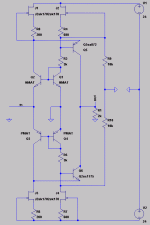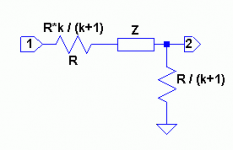Re: Where is the schematic
original poster started a "discussion"
eventually, schematics may develop.
be patient ....
or propose something yourself.
back on topic:
as for me, i'm just now unpacking my phono equipment after moving a few years ago. also, no moving coil, so maybe i shouldn't comment at all.

i haven't done any discrete designs (yet) that i consider complete enough to evaluate; only op amp designs at this point. i played with active eq, passive eq, and combination. i ended up settling on a passive eq system with two gain blocks: front end AD745, passive eq, then OP637. rails provided by zener buffered by emitter follower.
sealed in an aluminum box. transformer, rectifiers, initial filter caps in remote box (not with preamp circuitry).
although i am ready to play around with some discrete designs (you guys did some great work in the blowtorch thread!), i have to say the design i saw with the AD745 feeding the AD844 with riaa eq at pin 5 of AD844 was quite intriguing. i forgot where i saw it - it's a commercial kit i think. I like the AD844 but haven't done anything at all with it yet.
mlloyd1
original poster started a "discussion"
eventually, schematics may develop.
be patient ....
or propose something yourself.
back on topic:
as for me, i'm just now unpacking my phono equipment after moving a few years ago. also, no moving coil, so maybe i shouldn't comment at all.

i haven't done any discrete designs (yet) that i consider complete enough to evaluate; only op amp designs at this point. i played with active eq, passive eq, and combination. i ended up settling on a passive eq system with two gain blocks: front end AD745, passive eq, then OP637. rails provided by zener buffered by emitter follower.
sealed in an aluminum box. transformer, rectifiers, initial filter caps in remote box (not with preamp circuitry).
although i am ready to play around with some discrete designs (you guys did some great work in the blowtorch thread!), i have to say the design i saw with the AD745 feeding the AD844 with riaa eq at pin 5 of AD844 was quite intriguing. i forgot where i saw it - it's a commercial kit i think. I like the AD844 but haven't done anything at all with it yet.
mlloyd1
Rembulan said:Heloo,
I dont see any schematic ? nobody brave enough to stand in front of the classs to write down the schematic.
I am afraid this thread become another what pavel called xxxxxxPUB
Yes, I did not intend to attach a schematic, just to start open discussion on topic.
Regarding OPA637, it is an excellent opamp, but remember that in case of active equalization we need unity gain stable device, unless we introduce additional resistor, that influences HF rolloff. Then further LP pole must be added to get appropriate frequency response.
Regarding OPA637, it is an excellent opamp, but remember that in case of active equalization we need unity gain stable device, unless we introduce additional resistor, that influences HF rolloff. Then further LP pole must be added to get appropriate frequency response.
PMA said:... we need unity gain stable device, unless we introduce additional resistor, that influences HF rolloff. Then further LP pole must be added to get appropriate frequency response.
Unless you like the idea of adding the "missing" breakpoint to correspond to the fact that the mastering lathes do not apply an infinite amount of HF boost. IIRC, the consensus is that 50KHz is a good compromise of the admittedly somewhat varied practice.
-- Martin
a high frequency zero is advocated by many people:
http://www.hagtech.com/pdf/riaa.pdf
there have been lots of threads on riaa preamps - do we need to repeat them all or could people point out a few of the better ones to advance to base for this thread?
less than a year old:
http://www.diyaudio.com/forums/showthread.php?s=&threadid=58884&perpage=25&pagenumber=1
(I look esp. for Nelson Pass' remarks)
http://www.hagtech.com/pdf/riaa.pdf
there have been lots of threads on riaa preamps - do we need to repeat them all or could people point out a few of the better ones to advance to base for this thread?
less than a year old:
http://www.diyaudio.com/forums/showthread.php?s=&threadid=58884&perpage=25&pagenumber=1
(I look esp. for Nelson Pass' remarks)
Hi,
currently, I'm trying variations of the shown input stage:
the nmat and pmat transistors are actually a that340-transistor array, R1 is currently 10k. This is followed by an passive riaa network. I'm experimenting with mosfets in place of Q2/Q6 and with a DC servo.
The second stage is a blowtorchstyle gain stage but not balanced. The sound ist very detailed and punchy. It is not balanced, but really worth exploring.
Rüdiger
currently, I'm trying variations of the shown input stage:
the nmat and pmat transistors are actually a that340-transistor array, R1 is currently 10k. This is followed by an passive riaa network. I'm experimenting with mosfets in place of Q2/Q6 and with a DC servo.
The second stage is a blowtorchstyle gain stage but not balanced. The sound ist very detailed and punchy. It is not balanced, but really worth exploring.
Rüdiger
Attachments
PMA said:Regarding OPA637, it is an excellent opamp, but remember that in case of active equalization we need unity gain stable device, unless we introduce additional resistor, that influences HF rolloff. Then further LP pole must be added to get appropriate frequency response.
Hi Pavel,
Have a look at the circuit below. Assume that R is held constant while k is varied. The transfer function of this circuit is:
V2/V1 = [1 / (k + 1)] * [R /(R + Z(s))]
It's interesting because varying k does not change poles or zeros, only the constant out front.
That said, trying an active circuit for moving-coil all in one shot would require lots of low-frequency open-loop gain. Maybe a composite op-amp?
Attachments
a low output mc impedance requires a low noise riaa feedback network that presents a heavy load at high frequencies so at least a buffer in the loop seems desirable, a cfa op amp also allows large loop gain boost too while driving the feedback network without loading the low noise input op amp and cfa op amps have enough extra bandwidth to simplify loop stabilization
added gain does complicate linear stability and overload recovery but can be dealt with, GHz "GBW product" is possible at audio frequencies (but the roll off above audio has to be faster than single pole)
I have built and measured composite op amp circuits with >90 dB total gain at 20 KHz, ~ 80 dB in loop gain - with much slower op amps than are easily had today
added gain does complicate linear stability and overload recovery but can be dealt with, GHz "GBW product" is possible at audio frequencies (but the roll off above audio has to be faster than single pole)
I have built and measured composite op amp circuits with >90 dB total gain at 20 KHz, ~ 80 dB in loop gain - with much slower op amps than are easily had today
andy_c said:
That said, trying an active circuit for moving-coil all in one shot would require lots of low-frequency open-loop gain. Maybe a composite op-amp?
Hi Andy,
I did not mean one opamp, but 2 independent opamp stages. 1st is completely linear with gain 20-30dB. 2nd makes RIAA equalization with similar gain, as for MM. This is a well known approach shown by Walt Jung, e.g.
This is my take on a Riaa concept. Riaa circuit in Feedback loop
Gain app 45 dB at 1 KHz, so for mc's an additional circuit is needed; a pre pre maybe or the LC-Audio light powered circuit??
Fite Riaa curve beautifully within 0.5 dB with most deviation as an extra lift in the base.
Gain app 45 dB at 1 KHz, so for mc's an additional circuit is needed; a pre pre maybe or the LC-Audio light powered circuit??
Fite Riaa curve beautifully within 0.5 dB with most deviation as an extra lift in the base.
Sorry
original poster started a "discussion"
eventually, schematics may develop.
be patient ....
or propose something yourself.
Sorry for all who read my coment to sharp, I read many pavel comment in other thread also seeing so works he has done I hope to see some thing more than just a short coment. I dont believe he is a NATO guy, isn't he ?
original poster started a "discussion"
eventually, schematics may develop.
be patient ....
or propose something yourself.
Sorry for all who read my coment to sharp, I read many pavel comment in other thread also seeing so works he has done I hope to see some thing more than just a short coment. I dont believe he is a NATO guy, isn't he ?
My own RIAA amp with passive RIAA network
I plan (some time in the future) to design a RIAA amp with passive RIAA network. Specifications so far can be read at my homepage, see link below.
NE5534, LT1028, LT1115, LME49710, AD745, AD797 will be opamps in mind, both DIL08 and SO08
I plan (some time in the future) to design a RIAA amp with passive RIAA network. Specifications so far can be read at my homepage, see link below.
NE5534, LT1028, LT1115, LME49710, AD745, AD797 will be opamps in mind, both DIL08 and SO08
Walt Jung did a great paper on the tradeoffs between passive and active equalization. I can't get to it - maybe someone can post up a link. IIRC, it included some commentary on split architecture equalisation as well.
Seems to me this is another subject where we are going to have to agree to disagree - especially if you throw in the zero feedback or with feedback option as well.
Seems to me this is another subject where we are going to have to agree to disagree - especially if you throw in the zero feedback or with feedback option as well.
Bonsai said:Walt Jung did a great paper on the tradeoffs between passive and active equalization. I can't get to it - maybe someone can post up a link. IIRC, it included some commentary on split architecture equalisation as well.
The link to Walt's RIAA articles is here
Thanks Andy.
Starting point now might be to develop two theoretical circuits and explore the performance and compare them.
I like JCX's CFA suggestion for the active approach - however, would the noise performance be equal to that of a really good low noise VFA - say like the LT1115 or the new NS op-amps?
I'm still pondering which is better - th e IC op-amp route or a discrete approach.
Talking about the topology, I do have a predilection for the active a approach due to headroom requirements on the passive approach and possibly higher overall noise.
Starting point now might be to develop two theoretical circuits and explore the performance and compare them.
I like JCX's CFA suggestion for the active approach - however, would the noise performance be equal to that of a really good low noise VFA - say like the LT1115 or the new NS op-amps?
I'm still pondering which is better - th e IC op-amp route or a discrete approach.
Talking about the topology, I do have a predilection for the active a approach due to headroom requirements on the passive approach and possibly higher overall noise.
- Status
- This old topic is closed. If you want to reopen this topic, contact a moderator using the "Report Post" button.
- Home
- Source & Line
- Analogue Source
- Solid state phono preamp design philosophy

